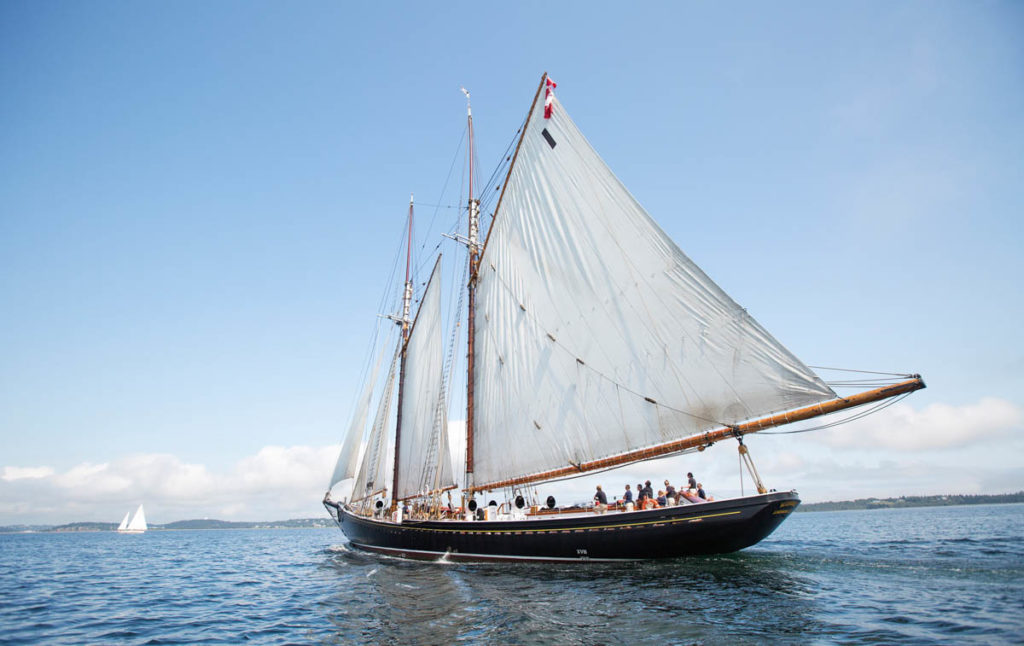The iconic racing schooner immortalized on Canada’s silver dime is celebrating its 100th anniversary.
This year marks 100 years since the original Bluenose slipped into the water off the coast of Lunenburg, Nova Scotia and set her sails on victory until becoming an icon of Nova Scotian culture and Canadian history. Now her replacement the Bluenose II will embark on an adventure across Eastern Canada in her honour.
On March 26th, 1921 the original Bluenose left Smith & Rhuland Shipyard and began winning races, both nationally and internationally, at a steady clip 17 consecutive years. Designed by naval architect William J. Roué and built in a remarkable 96 days, she started in a series of friendly fishermen’s races in the 1920’s, where at the time racing boats were banned but schooners circumvented the rules. With original captain Angus Walters at the helm, the Bluenose won nearly every competitor from 1921 until 1938. The key to her incredible speed has always remained an intentional mystery, but her upturned bow and remarkable ballast made her a standout among her peers. Her only defeat came against the American boat Gertrude L. Thebaud in the Lipton Cup in 1930. Never one to settle for second place, Bluenose would get her revenge in 1931 and again in 1938, in what would be her final race.
Captain Angus Walters would go on to purchase the Bluenose late in her racing career and appealed to the Canadian and Nova Scotia governments to help maintain her condition. Unfortunately with the outbreak of World War Two in 1939 the government had other pressing concerns and the “Queen of the North Atlantic” was sold in 1942 to the West Indies Trading Company. Sadly, her masts were chopped down and she was converted to a gas-powered freighter and in a reluctant end to her glory, she was sunk off Haiti in 1946 after hitting a reef.
Bluenose II was commissioned by Nova Scotian philanthropist and business owner Sidney Culverwell Oland in 1963 as a promotional yacht for his Oland Brewery and their ‘Schooner Lager’ brand. It was launched in Lunenburg like its predecessor on July 24th 1963, and was built to the original plans and by some of the same workers at the Smith & Rhuland Shipyard. Even original captain Angus Walters consulted on the design. Oland donated the schooner to Nova Scotia in 1971 to serve as an ambassador and promotor for Nova Scotia tourism. As part of the deal, and out of respect to her predecessor’s record, the Bluenose II has not competed in racing.
As for its 100th-anniversary adventure, the Bluenose II will be making stops throughout Eastern Canada over the next three weeks. According to captain Phil Watson, “We’ll be gone for three weeks from Lunenburg, and we won’t be going ashore in that time. So lots of ports to visit, and we’ll be anchoring out. Hopefully putting up flags and lights to promote the ship. And hopefully getting people to come out and see us. “
The route has several stops in some of Eastern Canada’s most well-known ports where fellow boaters and sailors are invited to come see the ship.
“The first stop is Cape Breton. On the first leg we’re going up to the North Sydney yacht club. We’re actually too tall to fit under the Seal Island bridge, so we have to make the Bluenose smaller and lower our mainmast. We’ll go up through the lakes and anchor off Groves Pointe Provincial Park. We’ll come out and we’ll be somewhere close to the big fiddle in Sydney. Then down to Canso, Whitehead, and then back to Lunenburg.”







